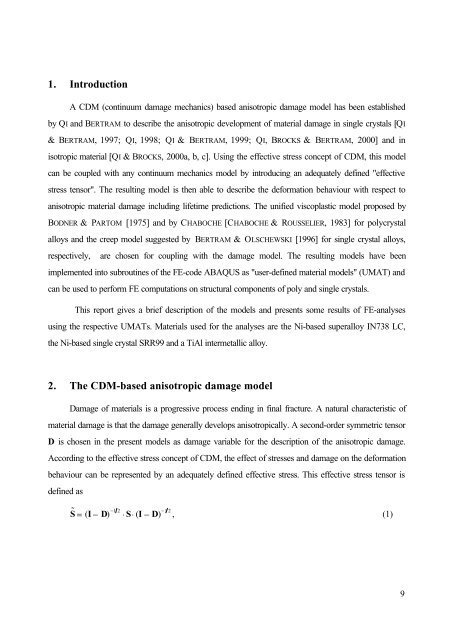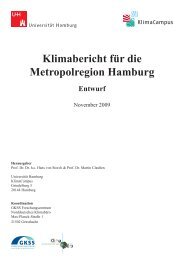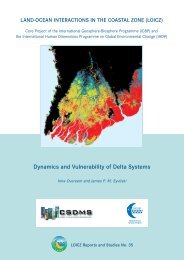ABAQUS user subroutines for the simulation of viscoplastic - loicz
ABAQUS user subroutines for the simulation of viscoplastic - loicz
ABAQUS user subroutines for the simulation of viscoplastic - loicz
You also want an ePaper? Increase the reach of your titles
YUMPU automatically turns print PDFs into web optimized ePapers that Google loves.
1. Introduction<br />
A CDM (continuum damage mechanics) based anisotropic damage model has been established<br />
by QI and BERTRAM to describe <strong>the</strong> anisotropic development <strong>of</strong> material damage in single crystals [QI<br />
& BERTRAM, 1997; QI, 1998; QI & BERTRAM, 1999; QI, BROCKS & BERTRAM, 2000] and in<br />
isotropic material [QI & BROCKS, 2000a, b, c]. Using <strong>the</strong> effective stress concept <strong>of</strong> CDM, this model<br />
can be coupled with any continuum mechanics model by introducing an adequately defined "effective<br />
stress tensor". The resulting model is <strong>the</strong>n able to describe <strong>the</strong> de<strong>for</strong>mation behaviour with respect to<br />
anisotropic material damage including lifetime predictions. The unified <strong>viscoplastic</strong> model proposed by<br />
BODNER & PARTOM [1975] and by CHABOCHE [CHABOCHE & ROUSSELIER, 1983] <strong>for</strong> polycrystal<br />
alloys and <strong>the</strong> creep model suggested by BERTRAM & OLSCHEWSKI [1996] <strong>for</strong> single crystal alloys,<br />
respectively, are chosen <strong>for</strong> coupling with <strong>the</strong> damage model. The resulting models have been<br />
implemented into <strong>subroutines</strong> <strong>of</strong> <strong>the</strong> FE-code <strong>ABAQUS</strong> as "<strong>user</strong>-defined material models" (UMAT) and<br />
can be used to per<strong>for</strong>m FE computations on structural components <strong>of</strong> poly and single crystals.<br />
This report gives a brief description <strong>of</strong> <strong>the</strong> models and presents some results <strong>of</strong> FE-analyses<br />
using <strong>the</strong> respective UMATs. Materials used <strong>for</strong> <strong>the</strong> analyses are <strong>the</strong> Ni-based superalloy IN738 LC,<br />
<strong>the</strong> Ni-based single crystal SRR99 and a TiAl intermetallic alloy.<br />
2. The CDM-based anisotropic damage model<br />
Damage <strong>of</strong> materials is a progressive process ending in final fracture. A natural characteristic <strong>of</strong><br />
material damage is that <strong>the</strong> damage generally develops anisotropically. A second-order symmetric tensor<br />
D is chosen in <strong>the</strong> present models as damage variable <strong>for</strong> <strong>the</strong> description <strong>of</strong> <strong>the</strong> anisotropic damage.<br />
According to <strong>the</strong> effective stress concept <strong>of</strong> CDM, <strong>the</strong> effect <strong>of</strong> stresses and damage on <strong>the</strong> de<strong>for</strong>mation<br />
behaviour can be represented by an adequately defined effective stress. This effective stress tensor is<br />
defined as<br />
˜<br />
S = (I − D) −1 2 ⋅S⋅ (I − D) −12 , (1)<br />
9





